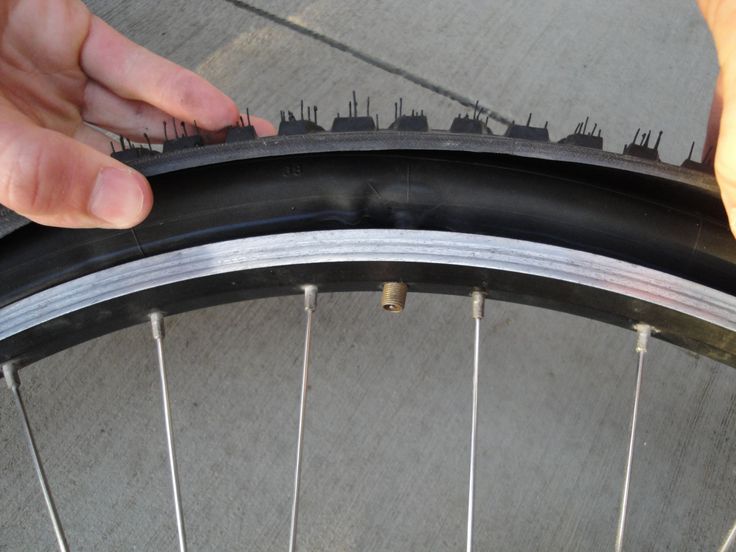Removing an inner tube for repair or replacement can sometimes be a real fight but with a bit of patience and a few pro tips, you can make things a lot easier for yourself.
Our tech team are switching tyres and tubes on a weekly basis so here are their top tips to get the job done.
If you're looking for more helpful maintenance advice, Cyclingnews is bringing you a series of guides so that you can learn how to perform basic bike maintenance tasks yourself. Check out the other guides that are available:
If you can get the tyre on and off without levers then that minimises the accidental pinch risk, but that’s a big ask with some tyre and rim combinations. Invest in quality levers, as cheap ones can bend or snap, and beware old-school metal levers particularly if you’re using carbon rims.
You also need a decent pump. A hand pump will be fine for lower pressures on a gravel bike, but if you’re heading upwards of 60psi then a proper workshop track pump makes things much easier. Obviously, you’ll need a fresh inner tube that’s the right size for your tyre and has the right valve type and valve length.
Today's best deals
Reduced Price
Lezyne Power Lever XL
$11.99
$8.99
View
See all prices
Lezyne Alloy Floor Drive pump
$89.84
View
See all prices
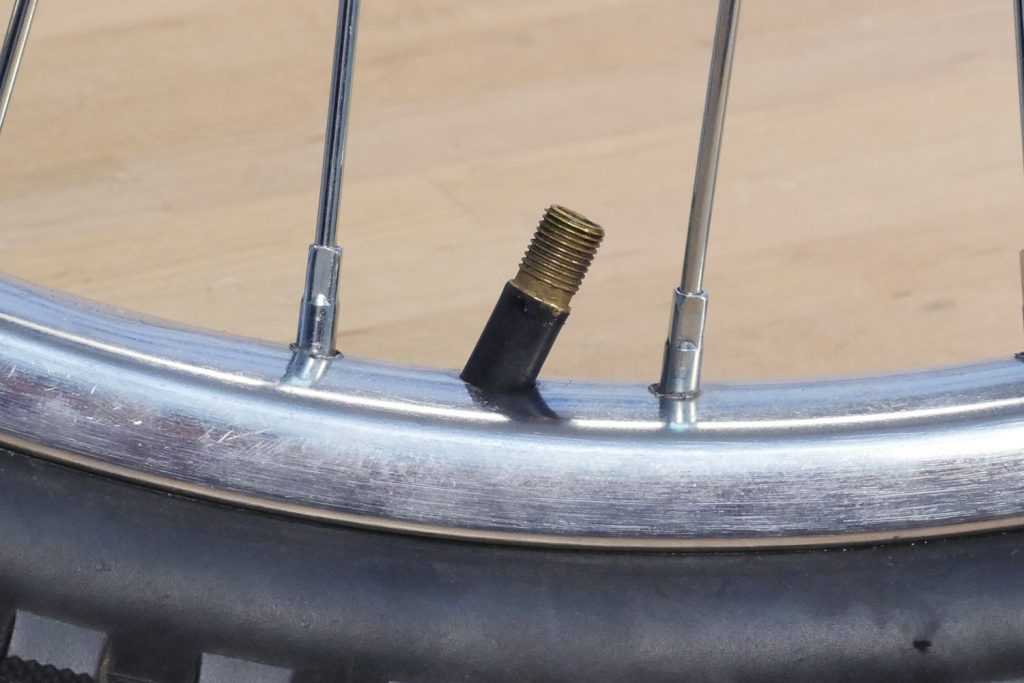 Deflate the tyre
Deflate the tyreFirstly you need to remove the wheel from the bike. Now if the tyre isn’t already fully deflated, let the air out of the inner tube by loosening the small barrel at the top of the Presta valve slightly and then pressing it down. Now unscrew and remove the knurled collar at the base of the valve.
If you’re working on a kid's bike or mountain bike with the car-style Schrader valve, then depress the pin in the centre of the valve to let the air out.
Unseat the tyre from the edge of the rim to create slack (Image credit: Mick Kirkmann)With the innertube deflated, squeeze the tyre inwards to push the bead into the centre of the rim. Do this all the way around the tyre on both sides so it feels baggy on the wheel.
Gather all the slack to one point and push the tyre over the edge of your rim with your thumbs (Image credit: Mick Kirkmann)If the tyre is a loose fit, you can lift the whole wheel by the tyre and give it a shake to get all the slack to one place. Otherwise, you’ll have to collect that slack manually by pushing the tyre around the wheel in both directions simultaneously, aiming to make it as baggy as possible when your hands meet again at the bottom of the wheel.
Otherwise, you’ll have to collect that slack manually by pushing the tyre around the wheel in both directions simultaneously, aiming to make it as baggy as possible when your hands meet again at the bottom of the wheel.
If there’s plenty of slack or you’re just feeling strong, push the edge of the tyre off the rim with your thumbs. This isn’t just about flexing your skills and tendon toughness, it also removes any chance of trapping the inner tube between the rim and the tyre lever, and puncturing it. It’s worth persevering if you can.
Image 1 of 2
Hook the tyre lever under the tyre and lever it out of the rim (Image credit: Mick Kirkmann)Slide the tyre lever along to rim to unseat the tyre (Image credit: Mick Kirkmann)Don’t be ashamed if you need to use tyre levers though, just be careful. Sneak both levers under the bead about 2cm/1inch apart with the spoon side hooking under the bead of the tyre. Make sure you haven’t trapped the inner tube against the rim with the other side or you’ll create another puncture you need to fix.
Press one of the levers down to hoist the tyre edge over the rim, then press the second one down to pull a longer section of the tyre clear. Hook one of the tyre levers around the nearest spoke to keep the tyre from creeping back onto the rim.
If the tyre is really tight then you might need to use both levers simultaneously to pry the tyre over the rim. If you're using two levers to work away at a very tight tyre, be careful, as there's often a risk of things going flying. Watch yourself and keep the danger zone away from valuables.
Once removed the tyre can be easily inspected for cuts or wear (Image credit: Mick Kirkmann)Now work around the whole tyre with the levers until it’s completely off the wheel all the way around. Leave the far side of the tyre in place and push the valve back through its hole before gently pulling the inner tube out.
With the inner tube removed it’s a good time to check the tyre for any damage or splits in the tread.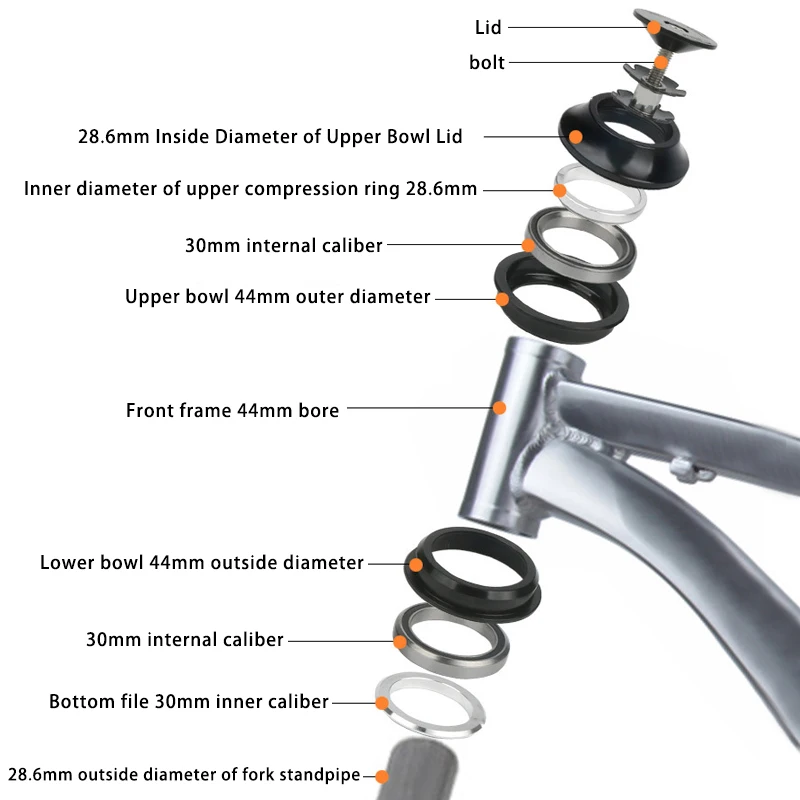 Check for thorns, nails etc. that might have penetrated through to the inside and remove them, otherwise they’ll puncture the fresh inner tube as soon as you put it in. Be careful if you’re running your finger around inside the tyre without looking first, as you don’t want to puncture yourself! Check the rim of the wheel for cracks, dents or sharp edges too.
Check for thorns, nails etc. that might have penetrated through to the inside and remove them, otherwise they’ll puncture the fresh inner tube as soon as you put it in. Be careful if you’re running your finger around inside the tyre without looking first, as you don’t want to puncture yourself! Check the rim of the wheel for cracks, dents or sharp edges too.
If it isn’t already lined up, pull the tyre around so the name or logo matches up with the valve hole. It makes it much easier to find the valve in a hurry, gives you an easy reference point for finding punctures, and it looks better in pictures too.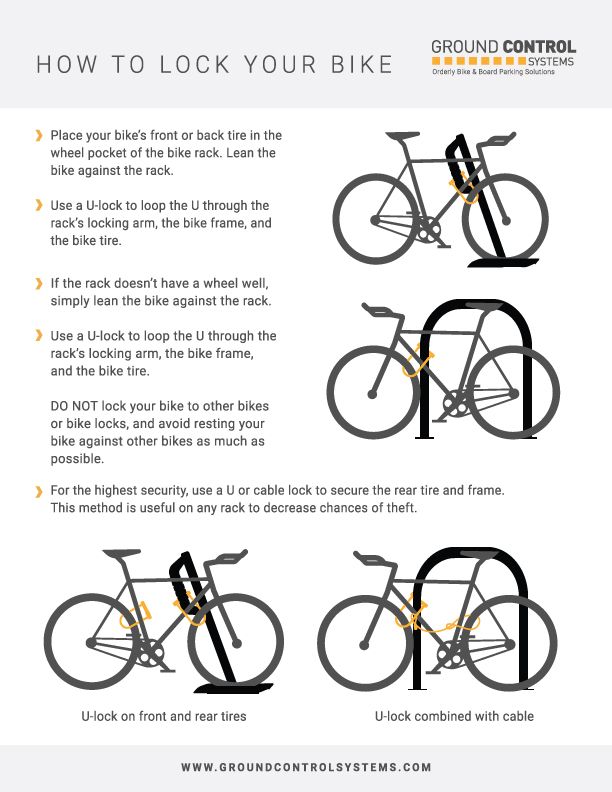
To reduce the risk of pinching, inflate the inner tube enough for it to take some shape. Remove the threaded collar, keeping it handy for later, and then push the inner tube valve through the rim. Massage the inner tube into the belly of the tyre, so it doesn’t push out over the rim edge. Be mindful as you do this, and avoid twisting or pinching the inner tube.
Some tyres can be slid on using only your hands (Image credit: Mick Kirkmann)Starting opposite the valve use your thumbs to start persuading the tyre back onto the rim. If you're working with tight tyres, remember how you moved the slack of the tyre into one place before removal, and try to emulate that movement as you push the tyre back onto the rim. You want to be left with as much slack as possible for the last part of the process. Be super careful not to trap and puncture the inner tube between the bead and the rim.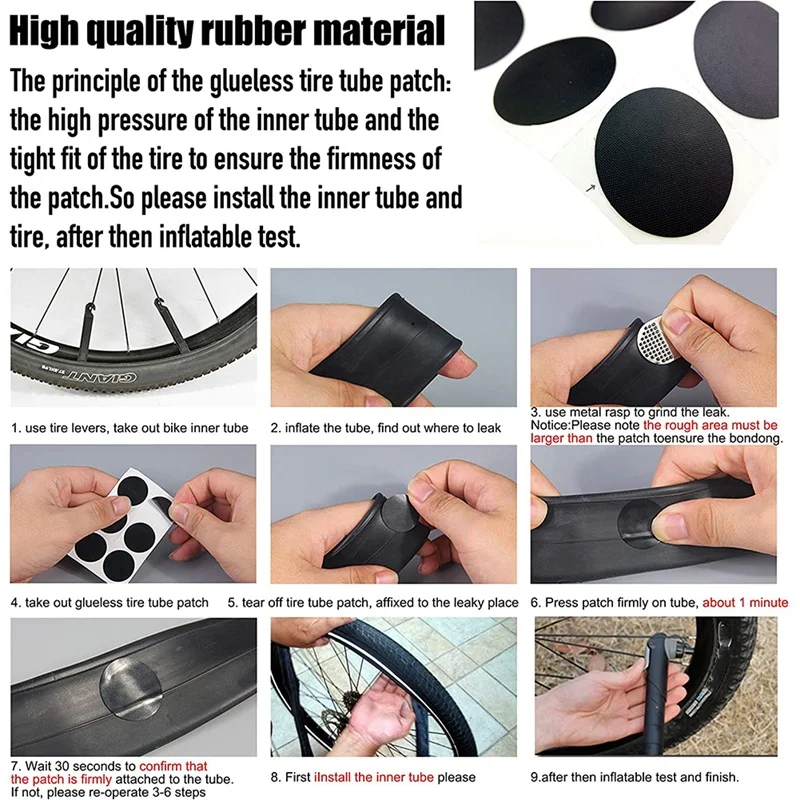
Try to get the tyre on with your thumbs as far as white knuckle, tendon straining determination will take you. When you really can’t get it on any further by hand insert the levers carefully under the tyre edge. Position them about an inch/2.5cm from each unfitted end. Brace one lever against the tyre to stop it slipping back and then use the other lever to lift the tyre onto the rim. Alternate this action working inwards towards the valve.
Carefully inflate the tyre whilst checking for pinches or bulges (Image credit: Mick Kirkmann)Once the tyre is on, double-check that there are no bits of inner tube poking out. Push the valve back into the tyre to check that it's not trapped and then thread the lock ring back onto the valve to secure it into the rim. Keep checking all the way round as you gradually inflate the inner tube, watching for any inner tube hernias or weird bulges and bumps in the tyre.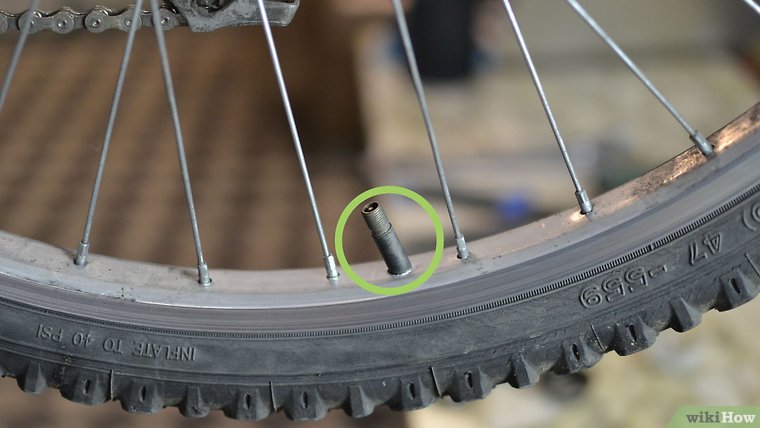 Increase pressure until the tyre pops into place all around the wheel, using the line on the bottom edge as a guide to check it’s properly positioned all the way around.
Increase pressure until the tyre pops into place all around the wheel, using the line on the bottom edge as a guide to check it’s properly positioned all the way around.
With the tyre up to the right pressure, remove the pump and spin the wheel to double check alignment both side to side and vertically. If there’s anything weird going on, deflate and massage the affected area to re-centre the tube and tyre before re-inflating.
Once you’re happy that everything is settled, you’re ready to ride. Make sure you check the tyre frequently on the first couple of rides, in case something sneaks out of place. Finally, always check both tyres for pressure, damage or debris after every ride.
Today's best road bike tyre deals
Reduced Price
Schwalbe Pro One tubeless tyres
$60. 02
02
$54.57
View
See all prices
Reduced Price
Continental GP5000 Clincher Road Tyre
$87.95
$49.75
View
See all prices
Reduced Price
Vittoria Corsa G2.0 TLR Road Tyre
$87.99
$54.55
View
See all prices
Vittoria Rubino Pro Graphene 2.0 Road
$64. 99
99
View
See all prices
Reduced Price
Pirelli PZero Velo Road Tyre
$58.99
$51.02
View
See all prices
Individuals carrying out the instructions in this guide do so at their own risk and must exercise their independent judgement. There is a risk to safety if the operation described in the instructions is not carried out with the appropriate equipment, skill and diligence and therefore you may wish to consult a bike mechanic. Future Publishing Limited provides the information for this project in good faith and makes no representations as to its completeness or accuracy. To the fullest extent permitted by law, neither Future Publishing Limited, its supplier or any of their employees, agents or subcontractors shall have any liability in connection with the use of this information, provided that nothing shall exclude or limit the liability of any party for personal injury or death caused by negligence or for anything else which cannot be excluded or limited by law.
Thank you for reading 5 articles in the past 30 days*
Join now for unlimited access
Enjoy your first month for just £1 / $1 / €1
Already have an account ? Sign in here
*Read any 5 articles for free in each 30-day period, this automatically resets
After your trial you will be billed £4.99 $7.99 €5.99 per month, cancel anytime. Or sign up for one year for just £49 $79 €59
Join now for unlimited access
Try your first month for just £1 / $1 / €1
Already have an account ? Sign in here
The latest race content, interviews, features, reviews and expert buying guides, direct to your inbox!
Contact me with news and offers from other Future brandsReceive email from us on behalf of our trusted partners or sponsorsWant to know how to change a bike inner tube?
Being able to change a bike inner tube is the most important maintenance skill any cyclist should learn.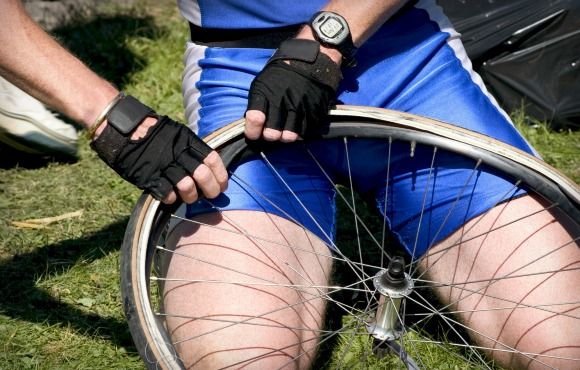
Not only is it the repair your bike will need the most often, it’s also possible to do at home with a bit of expert advice – saving you costly and unnecessary trips to the mechanic.
Most bike tires have two main components: the outer tire (the tough, grippy layer of rubber that makes contact with the ground) and the inner tube (the inflatable ring which holds in the air). So, when you have a flat tire, you’re more likely to need to know how to replace a bike inner tube than how to change a bicycle tire.
Punctures are an unavoidable fact of life for cyclists. Having the know-how to change a bike inner tube for yourself is the difference between riding again within a few minutes and sitting at the side of the road waiting for a taxi!
In this article, we’ll walk you through:
Ready to learn how to change a bike tube and get back in the saddle?
Let’s go!
Tire levers are a cheap but vital tool that every cyclist should own. They’re most useful as a pair and are small and light enough to be worth carrying on out-of-town rides when a puncture would leave you stranded.
They’re most useful as a pair and are small and light enough to be worth carrying on out-of-town rides when a puncture would leave you stranded.
Tire levers used to be made of metal, but plastic levers are most common now – they’re cheaper, lighter, and less likely to damage your wheel rims. It’s worth buying a decent pair of levers, as the cheapest ones tend to buckle under the pressure.
Shop For Tire Levers on Amazon
Hand pumps are fine for mountain bikes, but for the higher pressures used in road bike tires, it’s best to use a track pump (the type that sits on the floor with a T-bar handle at the top).
A hand pump will do enough to get you riding again on a road bike if you need a quick fix, but you should still top up the pressures with a track pump when you get the chance.
Check Out Track Pumps On Amazon
Different types and sizes of tires will need different inner tubes.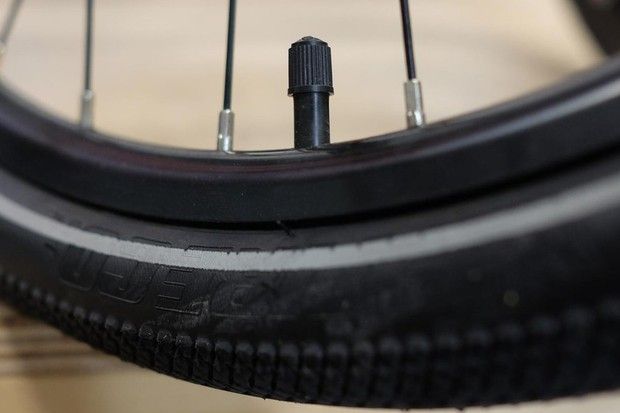 These measurements are often printed on the inner tube itself, so an easy way to check which to buy is to look at the punctured inner tube and make sure the new one is a match.
These measurements are often printed on the inner tube itself, so an easy way to check which to buy is to look at the punctured inner tube and make sure the new one is a match.
If you can’t find this on the old inner tube, the measurements should also be written on the sidewall of the outer tire.
Bike Inner Tubes On Amazon
Use a bike mount (or find something suitable to act as a stand) to hang the frame of the bike from while you remove the wheel. A low-hanging tree branch or a friendly fellow cyclist can be handy if you’re having to take the wheel off mid-ride!
If your bike has disk brakes, you’ll need to open them so that the wheel can slip out from between them. You can ignore this step if your bike has disc brakes, but you should take extra care not to bend them when you remove the wheel.
Most modern bikes use a quick-release mechanism to attach the wheels. Simply open the lever and unwind it slightly until there is enough room to remove the wheel from the forks.
Simply open the lever and unwind it slightly until there is enough room to remove the wheel from the forks.
If you don’t have a quick release, your wheel might be secured by a thru-axle. These are increasingly popular on new high-end mountain bike models, though they’re beginning to appear on road bikes too. Thru-axles have a small handle that can easily be unscrewed by hand.
Older bikes sometimes use hexagonal axle bolts, which may need to be loosened with a spanner. You can find bike spanners that are small enough to be taken out with you on rides.
Check Out Portable Bike Spanners On Amazon
If you’re removing the front wheel, you should now be able to lift it away from the bike to begin changing the inner tube!
If you’re working on the rear wheel, you should first shift the chain into the smallest sprocket (the hardest gear) at the back. You’ll then need to pull the derailleur backward as you remove the wheel so that it has space to slide out.
Deflating the inner tube will make the outer tire easier to remove. You should still follow this step even if the tire already feels flat, as an inner tube with a slow puncture can still hold enough air to make removing it difficult.
If there’s a securing nut around the valve, unscrew it once all the air is out.
Using your hands, press both sides of the tire inwards towards the middle of the rim’s width. Once you’ve worked your way around the whole tire, it should begin to feel a little loose on the wheel.
Now you’ll need to put your tire levers to use. Insert the pair of them under the bead of the outer tire (the part of the tire which sits inside the rim), at the opposite end of the wheel from the valve. Try to position each of them in line with one of the wheel spokes, ideally around 4-6 inches (10-15cm) apart.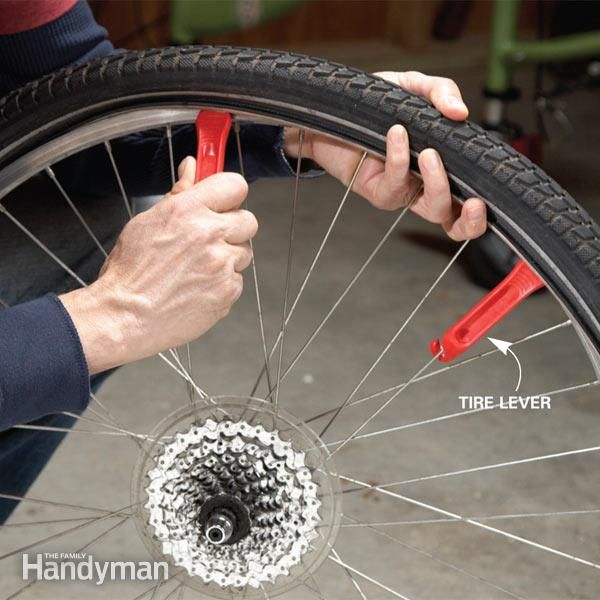
Press down on one of the levers to lift the edge of the tire up and over the rim, then hook the bottom of the lever around the spoke to hold it in place.
Next, do the same with the second lever to lift more of the tire over the rim. On a very tight tire, you might need to use both levers at the same time to ease the tire off.
Be careful though – when you’re applying that much force there’s always a risk of a tire lever pinging itself across the room!
Once you’ve lifted the first section of the outer tire off the rim with the levers, you should be able to pull the rest of it off with your hands. If it’s still too tight, unhook one of the levers from the spoke and slide it around the circumference of the tire, pulling it over the rim.
Remember, you’re only trying to lift the tire over the rim on one side. There’s no need to completely remove the outer tire from the wheel!
Push the valve back through its opening on the wheel, then pull the inner tube out from underneath the side of the outer tire that’s hanging over the rim.
That’s the first half of the job done!
Before fitting your new inner tube, check the outer tire to make sure the sharp object which caused the puncture is gone. This is an essential step that cyclists often forget!
If it’s still there, it could puncture your new inner tube as soon as you’ve fitted it and you’ll have to start over.
To inspect the tire, reach inside and carefully press your fingers all the way around it. Go slowly – you don’t want to let the same thorn or glass shard which punctured your inner tube puncture your finger as well!
A great tip used by experienced riders is to always keep a ball of cotton wool stashed in your cycling jersey. The wool will snag on anything sharp when you run it around the inside of the tire, so you can find and remove the cause of the puncture without putting your fingers at risk!
If the outer layer is looking very worn and has lost its tread, it’s also worth learning how to change a bicycle tire.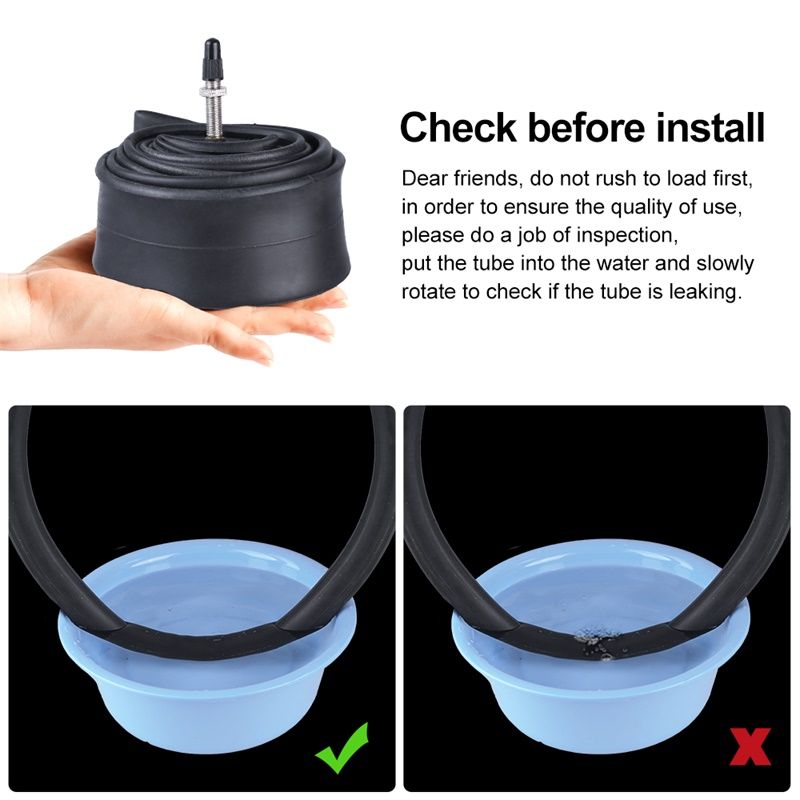 Pull the damaged outer tire the rest of the way off the wheel. Then, fit one side of the replacement outer tire over the rim, ready for the new inner tube to be installed.
Pull the damaged outer tire the rest of the way off the wheel. Then, fit one side of the replacement outer tire over the rim, ready for the new inner tube to be installed.
Before you try to install it, partially inflate the new inner tube – just enough for it to hold its shape. This will make it easier to fit while reducing the risk of the inner tube getting pinched.
First, push the valve through the hole in the rim, ensuring it is as straight as possible.
With the valve in place, gently tuck the rest of the inner tube inside the outer tire so that it sits inside the rim. Take care not to pinch or twist the inner tube, as this could cause a new puncture.
This part can get a little tricky, but there are some steps you can take to make it easier!
It’s best to position the wheel on the ground in front of you, with the valve at the bottom and the side of the tire which is hanging loose facing away from you.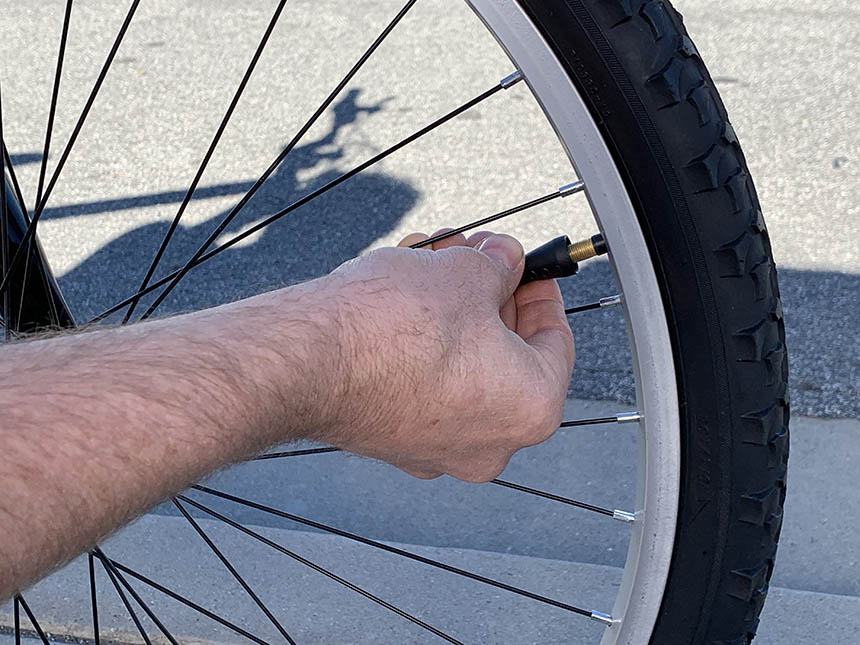
Starting at the top, use your fingers to tuck the bead of the tire back inside the rim. Once the top section is in place, use your thumbs to ease the rest of the tire back into place, working downwards towards the valve.
Try to follow this technique to re-fit as much of the tire as you can. Re-fitting the tire by hand is the best way to avoid pinching your new inner tube. When it starts getting difficult, you can squeeze the whole tire towards the middle of the rim to create some slack, as you did when removing the tire.
However, sometimes the tire is just too tight – no amount of grunting, sweating or swearing will force it back on by hand.
When your thumbs have taken you as far as they can, insert the tire levers under the edge of the tire with an inch or two (3-5cm) between them. Be careful not to trap the inner tube under the lever or you risk a puncture.
Gently raise the lever which is further from the valve, lifting the tire back onto the rim. Keep this in place while you raise the second lever, then remove the first lever and insert it a little further along. Repeat this alternating pattern towards the valve until the whole tire is back in place.
Keep this in place while you raise the second lever, then remove the first lever and insert it a little further along. Repeat this alternating pattern towards the valve until the whole tire is back in place.
With the tire back on the wheel, have a quick visual check to make sure none of the new inner tube is poking out. If it is, it might burst when you start to inflate it.
Slowly pump air into the tire to bring it back up to pressure. Check the tire’s sidewall to find out the recommended pressure window if you’re not sure.
Slot the wheel back into place and secure it. If it’s the back wheel, you’ll need to pull the derailleur back again to allow the wheel into position.
Don’t forget to reattach the brakes once the wheel is in!
Now you know how to change a bike inner tube!
Now you know how to change a bike tube, you should be ready to take your newly repaired bike out for a test ride!
If this is your first time changing a bike inner tube, it may seem like a daunting process with a lot of information to take in, and it might take you a little while to see it through.
But remember, changing a bike inner tube gets quicker and easier each time you do it – before you know it, you’ll need just a few minutes after suffering a puncture to get yourself back on the road again!
Tube Vs Tubeless Tires: What’s Best For Your Bike?
How High Should My Bike Seat Be? Proper Bike Seat Height Explained
How To Fix Squeaky Bike Brakes: Causes And Solutions
Proper Cycling Form – 14 Tips For Best Riding Practice
How To Cycle Faster: 9 Tips To Speed Up
If you are a cyclist, you need to be able to deal with a number of common problems that can happen on the road. A punctured wheel is one of the main ones. Unfortunately, you can run into a nail, a piece of metal or a broken bottle almost anywhere, and sooner or later it happens to everyone.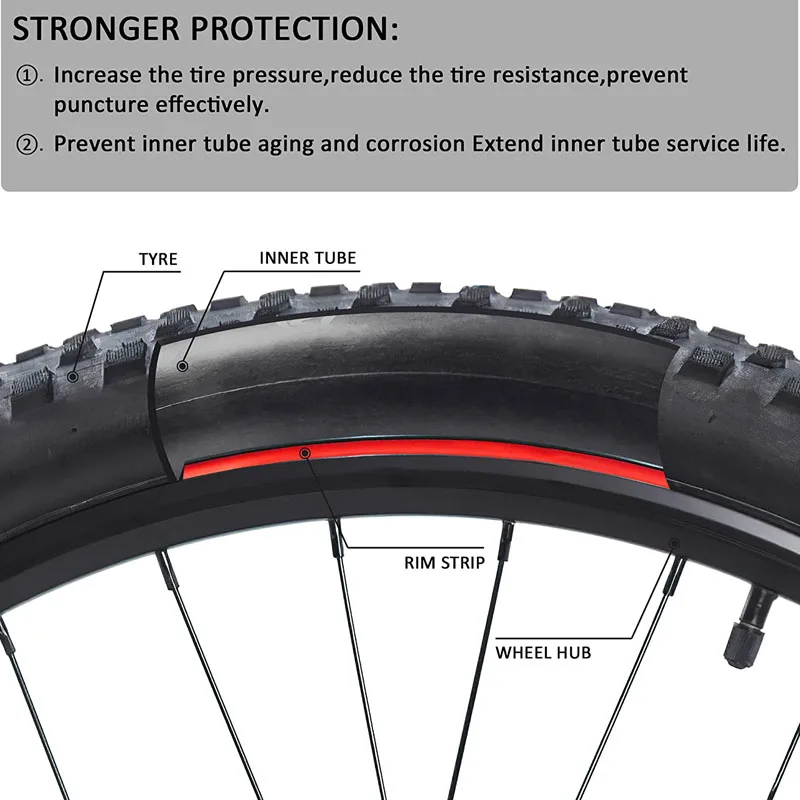 Already happened? Read our review, which we prepared together with Onliner, on how to change or seal the camera, tire on a bicycle. nine0003
Already happened? Read our review, which we prepared together with Onliner, on how to change or seal the camera, tire on a bicycle. nine0003
To remove the damaged tube from the wheel, you need to remove it from the bike - this is much more convenient to work with. Then follow the step by step instructions:
1. Unscrew the protective cap from the nipple. If necessary, completely deflate the wheel. This will make the job easier, as there will be no unnecessary resistance.
2. Using a pry bar, hook the edge of the tire and pull it out of the rim. Special tools allow you to carry out this procedure quickly and as painlessly as possible. If there is no pry bar, you can try using any thin and durable object, such as a spoon. Her handle has repeatedly rescued cyclists who did not have repair tools at hand. Just make sure she doesn't bend over. nine0003
Just make sure she doesn't bend over. nine0003
Important: The tool should not have sharp ends, so a screwdriver is not the best solution, although it fits the given shape. With it, you can only damage the wheel more. If you want to keep the tire, don't.
3. It is optimal to use two mounts. First, pick up the edge of one, then, when you fix the position, in 2-3 centimeters, pick up the tire with the second mount. This will be followed by a release of pressure, and the work will go easier. While continuing to support the first mount with your hand, continue prying the tire in a circle with the second until it is completely released from the rim. nine0003
4. Now that one end of the tire is completely out, release the nipple and remove the damaged tube.
We will consider the installation process with the installation of both a new camera and a tire. If you are keeping the old camera, skip the first step.
1. We put a new tire on one “rib” of the wheel, so that we have a free pocket for inserting the camera.
2. We take a new chamber (deflated) and, starting from the nipple, lay it along the rim. nine0003
3. While the camera is not yet closed, pump it up a little to make sure that it is laid flat and not twisted anywhere. If the tube is installed with a kink or twisted during installation, it will most likely burst as soon as you get on the bike. Agree, you don’t need such unnecessary frustrations, because these are not only ruined plans, but also additional financial costs.
4. Now you need to "fill" the tire into the rim. In the first steps, this is done manually, but at the end, installation will again be required. You can do it with one, but it's better to use two. Use it to pull the tire towards you a little so that it easily enters the rim. You can push the tire a little inward with a mount so that it is better fixed. The main thing is that the attachment depth is the same throughout the circle. nine0003
5. After the wheel is closed, pump up the chamber to the desired state. Usually the right pressure is indicated on the tire, check it to properly set your pump.
Usually the right pressure is indicated on the tire, check it to properly set your pump.
6. Now screw the cap on the nipple to fix the condition of the wheel.
7. It remains to install the wheel in place and that's it. Now your bike is back on track! Make a small circle on it at low speed to make sure everything is secured properly and you feel comfortable. If necessary, pump up the chamber of the second wheel so that they are equally elastic. After replacing one tube, many cyclists experience minor discomfort while riding. If everything is fine, you can go to the road. What if something happens, you already know how to change a tire and you can do it even in field conditions. nine0003
Try not to rush during the procedure and be careful at every step. Any carelessness can then turn into problems on the road. If you are saving an old tire, be sure to check the inside of it for any piercing or cutting elements. It often happens that part of the object that pierced the camera breaks off and remains in the tire. Doing so may damage the camera again. So, if you managed to find the "culprit" of the tragedy, make sure you extract it completely. nine0003
Doing so may damage the camera again. So, if you managed to find the "culprit" of the tragedy, make sure you extract it completely. nine0003
When working with the pry bar, be sure to hold it with your hand, even if it seems to you that it is holding itself. The resistance of the tire can easily push it out. In the best case, it will simply fall and you will have to start work again. At worst, it will fly out with force and can hit you in the face. The sensations are unpleasant, not to mention the fact that it can be traumatic.
Bicycle tires, inner tubes
A flat tire on a bicycle is a fairly common occurrence, especially when riding on rough terrain or using poor quality or worn tires.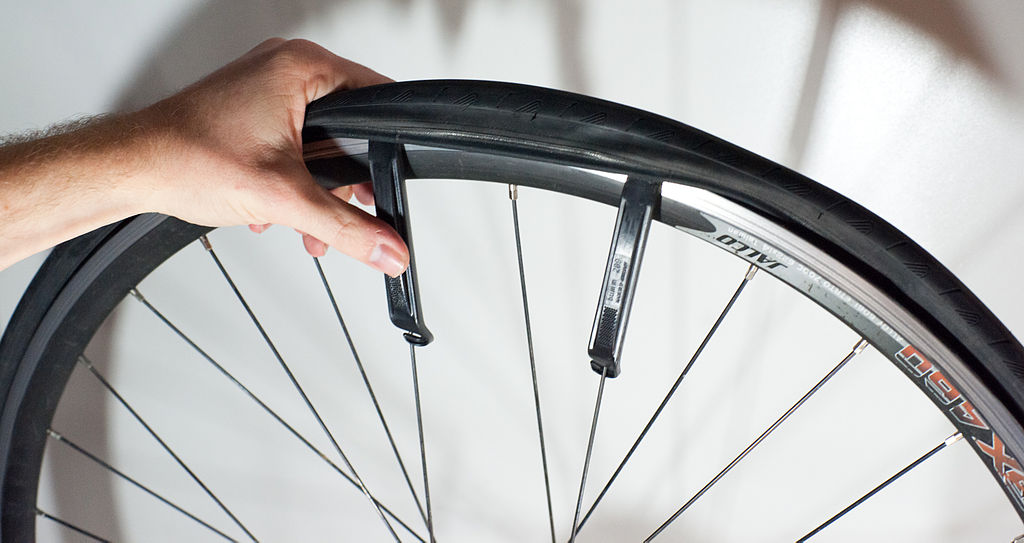 Such an unpleasant incident happens to a cyclist at least once a season, and some are "lucky" to change the camera two or three times in a short trip.
Such an unpleasant incident happens to a cyclist at least once a season, and some are "lucky" to change the camera two or three times in a short trip.
And if it takes five minutes for an experienced cyclist to change the tube on a bicycle, then for some reason beginners are very afraid to remove the tire on their own and most often drag their bike to a service or to friends. In fact, changing the camera is very simple:
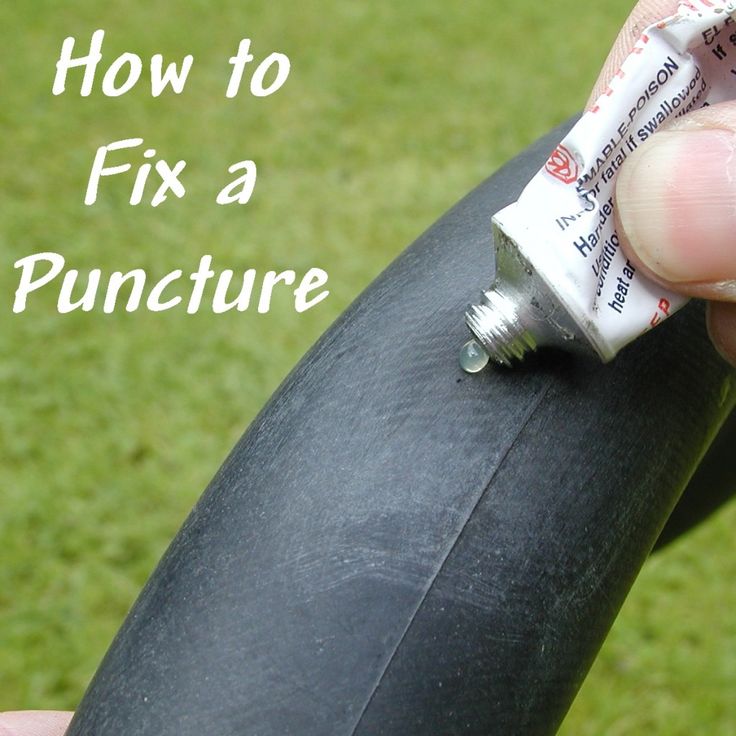 In this case, you can use any sufficiently thin and durable objects: various wrenches, a beer opener, or even a camping spoon. The only restriction: your tool should not have sharp ends, otherwise you will pierce the camera in a couple more places. Because of this, it is strongly not recommended to use screwdrivers, knives and other sharp objects to remove tires. It is also worth remembering that if you press too hard on the rim, you can damage it. As an example, in this manual we will use ordinary wrenches as montages, which were the first to come to hand - not the best, hiking option. nine0002 In order to pull the tire out of the rim, you need to pick up its edge with the first "wire" and pull it out of the rim. At the same time, the mount must be held so that the tire does not end up inside the rim again, and the mount itself does not fly into your forehead.
In this case, you can use any sufficiently thin and durable objects: various wrenches, a beer opener, or even a camping spoon. The only restriction: your tool should not have sharp ends, otherwise you will pierce the camera in a couple more places. Because of this, it is strongly not recommended to use screwdrivers, knives and other sharp objects to remove tires. It is also worth remembering that if you press too hard on the rim, you can damage it. As an example, in this manual we will use ordinary wrenches as montages, which were the first to come to hand - not the best, hiking option. nine0002 In order to pull the tire out of the rim, you need to pick up its edge with the first "wire" and pull it out of the rim. At the same time, the mount must be held so that the tire does not end up inside the rim again, and the mount itself does not fly into your forehead. After that, with the second mount, similarly pull out the edge of the tire next to the first mount.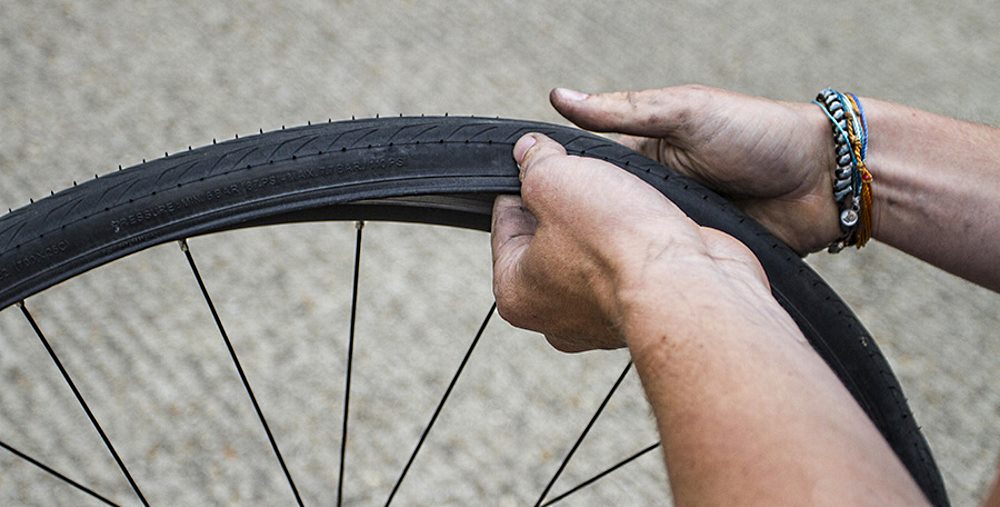 Don't forget to hold the first montage while doing this!
Don't forget to hold the first montage while doing this!
If the tire tension is still high after using two mounts, use the third one in the same way.
You should end up with one end of the tire completely out of the rim. nine0003
Done. Now you can start sealing the damaged camera or just install a new one.